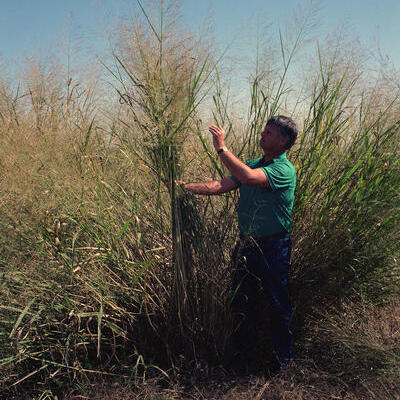Spikelets with one perfect terminal fl, lanceolate or fusiform to ovoid, obovoid, or globose, usually somewhat compressed dorsiventrally and biconvex; first glume very short or minute and usually scarious or membranous, or in some spp. nearly as long as the second; second glume about as long as the spikelet, herbaceous, green or colored, often prominently nerved; sterile lemma similar to the second glume, enclosing a palea and sometimes a staminate fl; fertile lemma indurate, usually white or pale and smooth or shining, veinless (or sometimes with 5–7 evident veins at full maturity), the margins inrolled over the edges of the indurate or membranous palea, the apex typically obtuse; ligule in most spp. a band of hairs, or obsolete; spikelets usually small, in panicles or spike-like racemes. 500, cosmop. (Dichanthelium) The spp. of subg. Dichanthelium, and especially spp. 21–34, form an intergrading group in which the taxonomic limits are difficult to discern and are still debatable. The flag-lf referred to in the descriptions of some spp. of subg. Dichanthelium is the uppermost lf of the culm.
Annuals or perennials. Culms erect, geniculately ascending or decumbent. Leaves basal or cauline; leaf blades filiform or linear to lanceolate or ovate, usually flat. Inflorescence usually a terminal open panicle, variously condensed or occasionally spicate rarely racemose. Spikelets usually symmetrical and dorsally compressed, disarticulating below the glumes; 2-flowered, the lower floret staminate or barren, the upper bisexual. Glumes herbaceous to membranous, ovate or oblong, obtuse to acute, acuminate or cuspidate; lower usually shorter than the spikelet, rarely equal, an internode between the glumes sometimes present, upper glume as long as spikelet, or slightly shorter; lower lemma similar to upper glume, with or without a palea; upper floret coriaceous, bony or cartilaginous, the margins of the lemma inrolled and clasping the palea, apex obtuse to acute or apiculate, crested or excavated. Hilum rounded to oval. x = 9, 10.
Annuals or perennials. Leaf-blades rolled or flat, linear to ovate; ligule a short ciliate membranous rim. Inflorescence a panicle, usually much branched but occasionally contracted about the primary branches. Spikelets usually spherical, ovate or oblong; glumes hyaline to membranous, usually the lower shorter than, and the upper as long as the spikelet; lower floret ♂ or barren, its lemma usually resembling the upper glume, with or without a palea; upper lemma ± as long as the spikelet, crustaceous, not crested, the margins inrolled and clasping only the edges of the palea. Caryopsis ± ellipsoid, dorsally compressed.
Spikelets paniculate or sometimes short-pedicelled in one-sided racemes; first glume minute to nearly as long as the spikelet; second glume and sterile lemma nearly equal, similar, the lemma often enclosing a hyaline palea and sometimes a staminate flower; fertile floret indurate, the nerves obsolete, the margins of the lemma inrolled, firmly enclosing the palea.
Superior lemma as long as or shorter than the spikelet, crustaceous, the margins involute and clasping only the edges of the palea.
Inferior floret male or barren, its lemma usually resembling the superior glume, with or without a palea.
Glumes hyaline to membranous, usually the inferior shorter than and the superior as long as the spikelet.
Inflorescence a panicle, usually much branched but occasionally contracted about the primary branches.
Caryopsis more or less ellipsoid, dorsally compressed.
Spikelets spherical, ovate, lanceolate or oblong.
Leaf laminae involute or flat, linear to ovate.
Annuals or perennials.

